
Browse an alphabetical list of photographs. These historical images portray people, places, and events before, during, and after World War II and the Holocaust.
<< Previous | Displaying results 1926-1950 of 2641 for "Photo" | Next >>
Public burning of "un-German" books in the Opernplatz (Opera Square). Berlin, Germany, May 10, 1933.
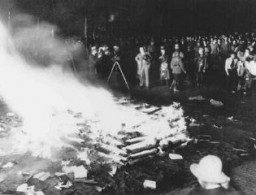
Public burning of "un-German" books in the Opernplatz (Opera Square) in Berlin. Students, some in SA uniform, march in a torchlight procession. Berlin, May 10, 1933.
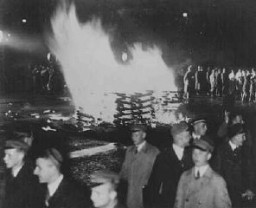
A group of young German boys view Der Stuermer, Die Woche, and other propaganda posters that are posted on a fence in Berlin, Germany, 1937.
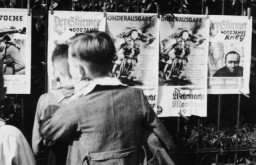
This photograph shows Julius Wolff, a young Jewish man, and Christine Neemann, his non-Jewish fiancé, standing between two police officers in Norden, Germany. Local SA men had accosted the couple and led them through the streets. The parade was meant to mock and humiliate the couple. Wolff wears a sign that reads: "I am a race defiler" ("Ich bin ein Rasseschänder"). Other photographs of this event show, and Neemann's testimony confirms, that Neemann was also forced to wear a sign. Neemann and Wolff…
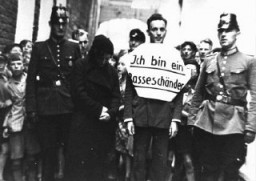
Two Jewish men (center, and at right in overcoat), carrying paint and brushes, who were forced by Austrian Nazis to paint "Jude" on the fronts of Jewish-owned businesses. Vienna, Austria, 1938.
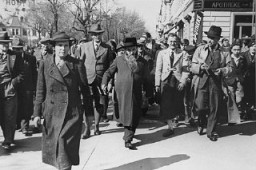
Three Jewish businessmen are forced to march down a crowded Leipzig street while carrying signs reading: "Don't buy from Jews. Shop in German businesses!" Leipzig, Germany, 1935.
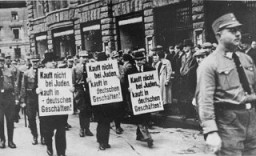
A pedestrian stops to read an issue of the antisemitic newspaper Der Stuermer (The Attacker) in a Berlin display box. "Der Stuermer" was advertised in showcase displays near places such as bus stops, busy streets, parks, and factory canteens throughout Germany. Berlin, Germany, probably 1930s.
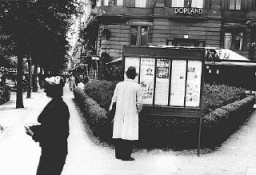
Students sit at their desks in a classroom at a Polish-language public elementary school in Lwów around 1930. In interwar Poland, Jewish children could attend public or private schools. The curriculum in these schools was based on a secular education, in contrast to the traditional heder where boys were schooled in Jewish texts and traditions. This particular school was located in the city’s predominantly Jewish neighborhood and almost all of the students were Jewish. Before attending this school,…

Purim portrait of a kindergarten class at the Reali Hebrew gymnasium. Kovno, Lithuania, March 5, 1939.
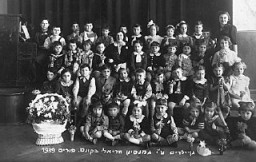
Père Jacques de Jésus (born Lucien Bunel) was a Carmelite headmaster of a Catholic boys school in Avon, France. Angered at Nazi policies, he made his school a refuge for young men seeking to avoid forced labor and for Jews. On January 15, 1944, the Gestapo raided the school, seizing Père Jacques and three Jewish children. The boys were deported to Auschwitz and killed. Père Jacques, sent to various concentration camps, died shortly after liberation.
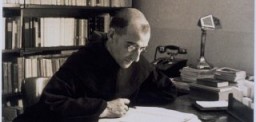
Amon Goeth, commandant of the Płaszów camp. Płaszów, Poland, between February 1943 and September 1944.
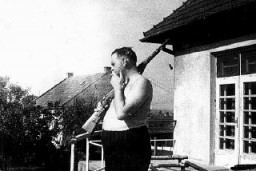
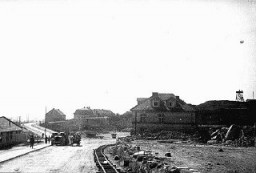
A woman (right) imprisoned in the Gurs camp stands with two Quaker delegates who worked for the American Friends Service Committee. Gurs, France, after January 1941.

Vegetable gardens administered by the American Friends Service Committee as part of a Quaker relief effort for prisoners at the Gurs camp. Gurs, France, ca. 1943.
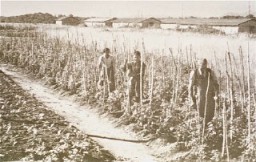
Quaker delegates of the American Friends Service Committee who set up a relief and rescue operation in Toulouse. France, January 1941.
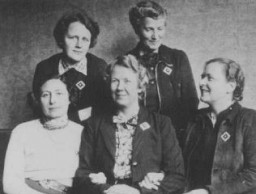
View of the quarry in a forced-labor camp established by the Hungarian government. Tokaj, Hungary, 1940.
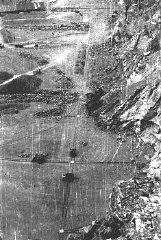
Quotation from Martin Niemöller on display in the Permanent Exhibition of the United States Holocaust Memorial Museum. Niemöller was a Lutheran minister and early Nazi supporter who was later imprisoned in the camp system for opposing Hitler's regime. First they came for the Socialists, and I did not speak out-Because I was not a Socialist.Then they came for the Trade Unionists, and I did not speak out-Because I was not a Trade Unionist.Then they came for the Jews, and I did not speak out-Because I was…
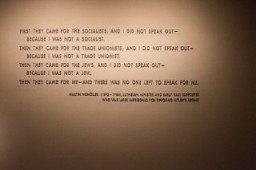
Rabbi Michael Dov Weissmandel, leader of the Working Group (Pracovna Skupina), a Jewish underground group devoted to the rescue of Slovak Jewry.
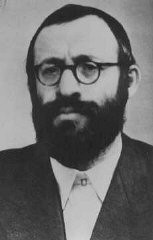
A technician determines the racial makeup of a young woman by the color of her hair.
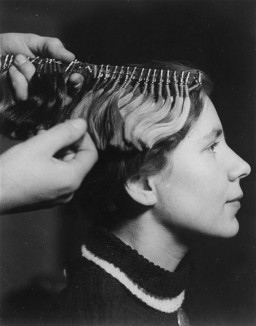
This 1938 racist illustration compares “German Youth” with “Jewish Youth.” It is subtitled, “From the face speaks the soul of the race.” It comes from Alfred Vogel's text Inheritance and Racial Hygiene. The Nazis used racist theories to label groups of people as inferior and as the "enemy." The Nazis claimed that "superior" races had not just the right but the obligation to subdue and even exterminate "inferior" ones.
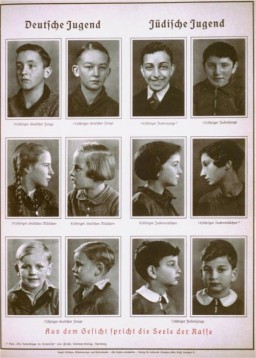
German police raid a vandalized Jewish home in the Lodz ghetto. Lodz, Poland, ca. 1942.
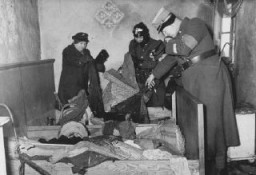
Rail cars discovered by Soviet forces and containing possessions taken from deportees. This abandoned train was on the way to Germany loaded with personal effects (in this case, pillows) taken from Auschwitz victims. Auschwitz, Poland, after January 27, 1945.
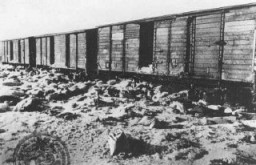
View of the railcar on display in the Permanent Exhibition of the United States Holocaust Memorial Museum. Washington DC, June 19, 1991. Courtesy of Polskie Koleje Panstwow S.A.
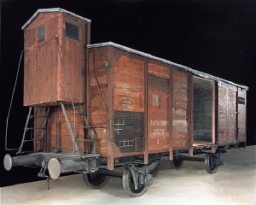
At the Jozsefvarosi train station in Budapest, Raoul Wallenberg (at right, with hands clasped behind his back) rescues Hungarian Jews from deportation by providing them with protective passes. Budapest, Hungary, 1944.

Raphael Lemkin (right) with Ambassador Amado of Brazil (left) before a plenary session of the General Assembly at which the Convention on the Prevention and Punishment of Genocide was approved. Palais de Chaillot, Paris, December 11, 1948.
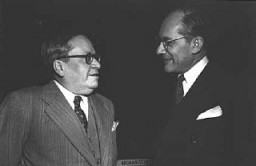
We would like to thank Crown Family Philanthropies, Abe and Ida Cooper Foundation, the Claims Conference, EVZ, and BMF for supporting the ongoing work to create content and resources for the Holocaust Encyclopedia. View the list of donor acknowledgement.